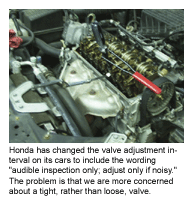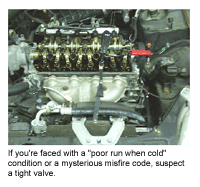While you can check the valves by listening in the intake manifold and exhaust pipe, I’ve found that it’s easier to hear the air that escapes from the tested cylinder into the manifolds and finds its way into the cylinder that has the valves open.
Now, let’s go back to the head gasket test. If, after a couple of minutes, there is no reaction in the radiator, remove the pressure, turn the engine counterclockwise until the next cylinder in the firing order is at TDC and do it again. Follow the firing order and test all of the cylinders.
The final gasket failure to consider is compression leakage between cylinders. This failure, and the resulting poor-run condition, is hard for a customer to miss. And, if it’s overlooked for any length of time, it will result in a very expensive repair. The aluminum cylinder head has little tolerance for those hot gases and extreme pressures passing over the mating surface, and it doesn’t take long for the casting to be damaged, resulting in the need for a rebuilt head to be installed.
In severe cases, the block will also be damaged. This failure will be evident with a compression test and will certainly be evident during a leak-down test. Be sure to remove all of the spark plugs before the compression test. This type of failure is rare on Hondas, and is often the result of the extreme cylinder pressures caused by detonation.
Don’t return the car without determining the cause. While it’s a good practice on all cylinder head service, be certain that the EGR ports are clear and the system functions as designed. Check exhaust backpressure, making sure a restriction there isn’t increasing cylinder temperature.
 MISFIRE/NO-START CONDITIONS
MISFIRE/NO-START CONDITIONS
Damaged valves are another problem that will require you to remove the cylinder head. Whether the valves are burnt or bent, these problems will result in a misfire condition that won’t take long to confirm. Both can be quickly identified with a compression test. Checking the valve lash will further confirm the condition.
As a rule of thumb, a burnt valve will have tight lash while the bent valve will be wide. Keep in mind that bent valves are the result of timing belt failure. If you find an engine that has bent valve symptoms, and no recent belt failure is reported or evident, consider carbon buildup on the valves and stems as a cause for the wide lash and lack of compression.
There have been cases reported where the combination of low compression and the absorbent nature of the carbon will cause a “no start” condition that disguises itself as a bad timing belt. If you’re checking the valve lash, you already know the belt didn’t break. In some cases, you can get the valve to seat by pushing the valve open and letting it “snap” shut.
 Another strategy is to put top-end cleaner into the manifold and let the car sit overnight so the chemical can soften the carbon. Be sure to crank the engine in the morning without the spark plugs installed to prevent hydrolocking the engine and the resulting damage. Whatever method you use, when you get the car running, a good top-end cleaning is certainly in order. Once a problem is confirmed and the head comes off, there are a couple of other tests to perform and decisions to be made before the head is reinstalled.
Another strategy is to put top-end cleaner into the manifold and let the car sit overnight so the chemical can soften the carbon. Be sure to crank the engine in the morning without the spark plugs installed to prevent hydrolocking the engine and the resulting damage. Whatever method you use, when you get the car running, a good top-end cleaning is certainly in order. Once a problem is confirmed and the head comes off, there are a couple of other tests to perform and decisions to be made before the head is reinstalled.
Whenever a head is removed, spend a few minutes with a flashlight looking closely at the head and ports. Carbon buildup should be easy to detect. Inspect the valves for any signs of overheating at the edges of the valve face. Look at the valves and seats that are being held open by the cam. Badly pitted, poorly seating valves should be serviced. If you did a leak-down test, pay particular attention to any cylinders that showed high leakage. Check the head for flatness using a straightedge. More than 0.003-in. of warpage should trigger a head resurface, while heads that have experienced extreme heat and the damage that comes with it may require replacement with a rebuilt unit to ensure a quality repair.
If you feel additional service is required, don’t hesitate to inform the customer. You’re doing him/her a favor by anticipating a problem that will require taking off the head again. When estimating an engine repair, it’s a good idea to explain that other problems could show up, so this situation won’t be a surprise. This is particularly important on engines damaged by overheating.
HEAD REASSEMBLY
Your service information will provide the nuts and bolts of reassembly procedures, but there are a couple things to keep in mind. When cleaning the gasket surfaces, it’s tempting to grab the offset die grinder and use surface refinishing discs. I suggest resisting the temptation. While “sanding off” the gasket may save some time, the resulting dust and material removal could compromise an otherwise first-class job.
There’s no reason this open engine doesn’t deserve the same treatment that you would give an engine you were rebuilding on a stand. The discs can also remove enough material from the edges of the gasket surfaces that sealing could be compromised. That doesn’t mean that traditional gasket removal doesn’t require care to avoid damaging parts or keeping debris out of the engine. It’s just less likely to be a problem.
When the surfaces are clean, be sure to check that the oil passage that brings oil to the camshaft and valvetrain is free of debris and clear on both the block and head.
I would say the only time you’ll get away with a simple gasket replacement is when you’re dealing with a lower-mileage car that hasn’t had the updated gasket installed. If the gasket failure is the result of an overheating situation, you’ll find the head is warped as a result of the heat. If it got really hot, it’s a safe bet that the valve seals felt it and should be replaced. At that point, a valve job seems like the way to go. Of course, it’s most important that the cause of the overheating is identified and repaired.
Hopefully you included a timing belt, water pump and thermostat in your estimate that will cover you there, but be sure to check the radiator and hose condition before you finish the estimate. Check the condition of the radiator cooling fins. On some models, you can get an idea of the internal condition by simply removing the cap, while others won’t afford that option. Have the radiator checked on a high-mileage car where there is no obvious cause for the overheating. When the car is done, pressure test it for leaks and make sure the cooling fans are working properly. It’s important that you let the customer know the head gasket failure was the result of an overheating problem and not the cause. Make them aware of the temperature gauge and how important it is that the engine runs at a stable temperature within the operating range.
VALVE JOBS AND RING REPLACEMENT
This brings us to the great ring debate. Hondas seem to have a problem with excessive oil consumption and the smoking that comes with it after a valve job has been performed. There are a couple of theories to support why this happens, but there is no disagreement that it does take place. It’s our policy to replace the piston rings whenever a valve job is performed. The good news is on the four-cylinder cars, this doesn’t make the job so expensive that it becomes out of the question for even an older car that’s in good shape.

